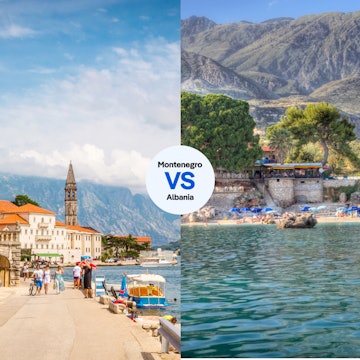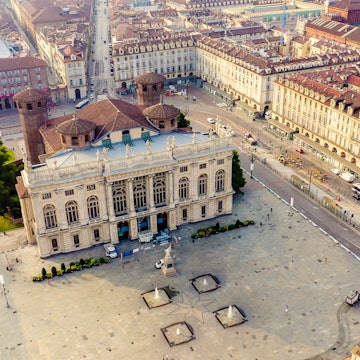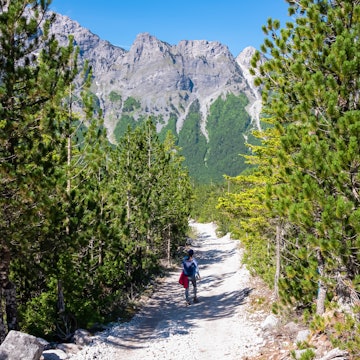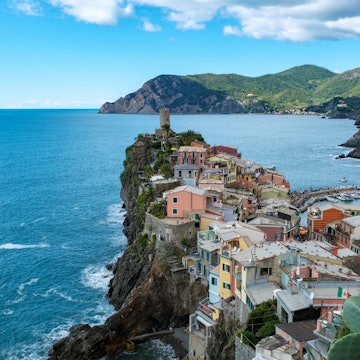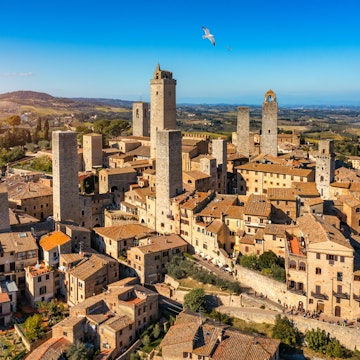
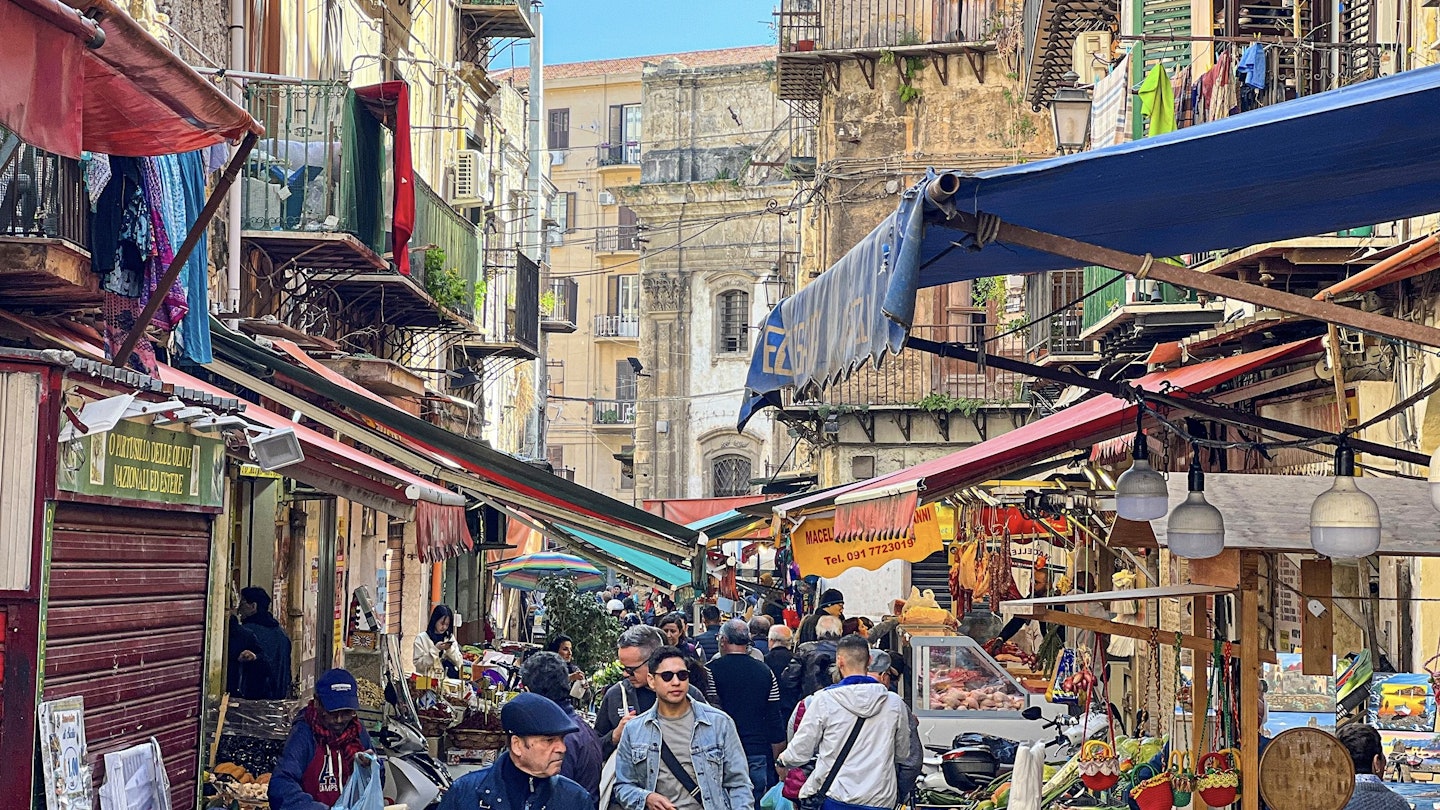
Palermo’s fabled, ever-crowded Mercato del Ballarò. Eric Isselee/Shutterstock
Sicily’s sun-spangled capital is one of those places that really gets under your skin.
Gold mosaics shimmer in a Norman king’s 11th-century pleasure palace. Dubai-style fountains shoot for the stars in a swanky 21st-century marina. Humble coppersmiths hammer out tin pots in a backstreet Ballarò workshop.
Here, you’ll be hard-pushed to avert your gaze.
Yes, Palermo is noisy, chaotic and rather dirty in spots, and the 24/7 urban cacophony can be exhausting. Yet this 3000-year-old city is insanely hypnotic despite – or because – all of that. Born as a huddle of Phoenician stores on a peaceful bay surrounded by the fertile Conca d’Oro plain, and later conquered by Arabs, Greeks and Normans, the city is a cultural masterpiece. Richly infused with Byzantine mosaics, arabesque domes, frescoed cupolas and the smell of goat intestines sizzling on street grills, it is also thrillingly sensorial.
If you’re headed to Palermo for the first time, you’re fortunate indeed. Here’s how to make the most of your trip.

When should I go to Palermo?
A primary point of entry for visitors arriving by plane en route to Sicily’s glorious beaches, islands and trio of crystal-clear turquoise seas, Palermo gets jam-packed in July and August. Everything sizzles, with temperatures rarely under 35ºC (95°F), often above 40ºC (104°). Anyone who loves noisy cafe terraces and sun-scorched squares will have a blast taking in summer’s kaleidoscope of stimuli.
For mellower souls, the slower-paced shoulder season – April to June and September and October – sees gentler temperatures (20–25ºC / 68–77°F) more conducive to strolling the city’s labyrinthine streets, spiraling up church towers without breaking a sweat and soaking up the city’s overdose of historic palazzi in a softer, cinematic light.
Winter (November to March) is a top-drawer time frame for a captivating weekend city break. Think sightseeing without crowds, engaging locals with ample time to chat and absorbing vitamin D in spades. Accommodation rates plummet, making this time a steal for budget travelers seeking Sicilian dolce vita on a shoestring. The open-house festival Le Vie dei Tesori, when hundreds of normally closed public monuments open to the public, is reason alone to visit in October.
How much time should I spend in Palermo?
A weekend or couple of days before scampering off to the coast ticks off Palermo’s big three: the UNESCO-listed cathedral, royal palace and hilltop village of Monreale, a 30-minute bus ride away.
Tacking on two more days allows you to tackle one blockbuster sight a day, then devote the remainder of your time to meandering around the centro storico (historic center). Expect to uncover hidden bars and artist workshops, stumble upon cherub-sculpted cloisters and backstreets tattooed with street art, and gaze down from rooftop bars on the city below. You’ll leave town planning a swift return.

Is it easy to get in and around Palermo?
Despite the noise from screeching scooters, vendors and Dolby Surround–level street babble that hits you on arrival, this larger-than-life city is easy to navigate. Getting into town by public transport from Aeroporto Falcone Borsellino, 35km (22 miles) from the center, is swift and efficient: count on 50 minutes by shuttle bus or train to the Via Tommaso Fazello bus station and adjoining Palermo Centrale train station. Save by purchasing Prestia e Comandè bus tickets in advance online.
Central Palermo is largely walkable – indeed, strolling the handsome length of pedestrian main streets Via Maqueda and Via Vittorio Emanuele (also called Corso Vittorio Emanuele) in the centro storico is an attraction in itself. For longer distances, jump in an iconic three-wheel Piaggio Ape taxi: there’s always a keen gaggle of them waiting, music blaring, at the Quattro Canti intersection.
Top things to do in Palermo
Expect something to suit every taste, budget and whim: rich art and history museums, a landmark art-nouveau opera house, cacophonous street markets, disruptive street art, ridiculously tasty street food, and extraodinary chapels encrusted in Byzantine mosaics and baroque cherubs. Better still, when you duck away from the tourist crowd into backstreet alleys, piazzas or out to sea, you’ll be rewarded with a thrilling repertoire of gutsy, grassroots sights and sounds.

See history in shimmering stone and gems at Palazzo dei Normanni
A rite of passage for every Palermo first-timer, the monumental Palazzo dei Normanni illustrates Sicily’s cultural complexity. Plan your visit for the start of your stay to learn the history and stories behind a compelling capital city of a massive kingdom that in the 12th century extended from Sicily to Albania, and from mainland Italy to North Africa. Conquering Arabs built the defensive fortress in the 9th century – yet it was Norman king Roger II’s artistic ambition three centuries on that bequeathed Palermo its rare crown jewel: the Cappella Palatina.
Words can’t convey the blinding beauty of the floor-to-ceiling artwork inside the palace chapel. Take in improbably detailed “Bible in pictures” mosaics crafted in shimmering gold and color by Byzantine Greek craftsmen in 1130, decorative wooden ceilings painted by Fatimid artists, exquisite inscriptions in Kufic script...Brace yourself for a treasure chest of artistic rarities you simply won’t see anywhere else in Europe.
Complete the history lesson next door at Arab-Norman Cattedrale di Palermo and Museo Diocesano: the 13th-century cathedral is a spectacular example of Sicily’s unique Arab-Norman architecture. End on the panoramic roof terraces to admire cragged crenellations, glittering maiolica cupolas and the city laid out at your feet. Coming at sunset is best.


Unravel the spellbinding world of Sicilian puppetry
Few cities reward wanders to the end of every street or peeks through doorways quite like theatrical Palermo. A stroll east from Teatro Massimo and into the messy web of old-world streets in working-class Vicciria uncovers the 1970s pocket theater of puppet master Giacomo Cuticchio. Shows at his Opera dei Pupi di Mimmo Cuticchio raise the curtain on Sicily’s most beloved form of traditional entertainment. Afterward, you can nip into the workshop to marvel at Cuticchio’s handmade rod marionettes up close.
In nearby Palazzo Branciforte, you can admire bloodthirsty Saracen warriors, sorcerers, chivalrous knights, princesses and other folkloric characters crafted by Cuticchio’s father and grandfather – enchanting and unnerving in equal measure. These uncannily human marionettes stare at you from antique wooden shelving that once displayed the most precious possessions of the city’s poor – for this elegant, 16th-century palazzo was a pawn house from 1848 until 1979.

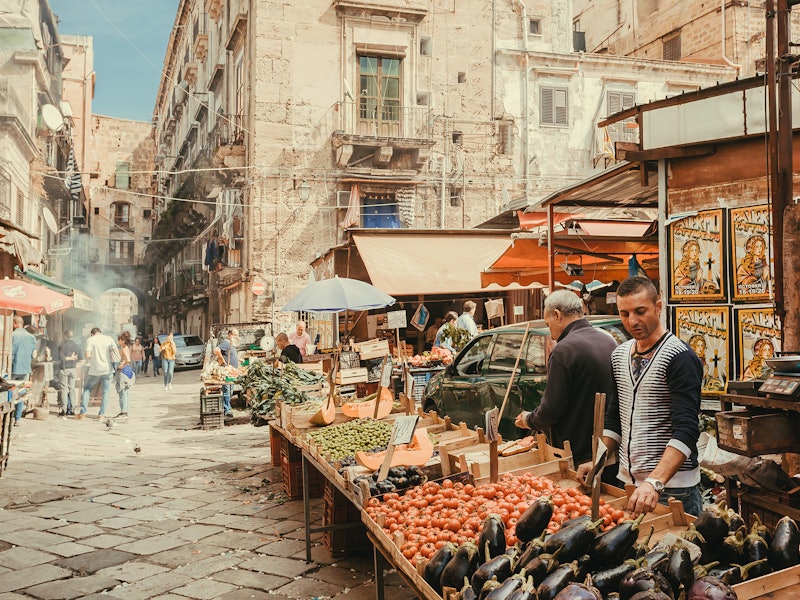
Immerse yourself in Palermo’s oldest street markets
You haven’t really “seen” Palermo until you’ve gotten lost in one of its open-air food markets. There are several to choose from; wherever you end up, the all-consuming bedlam – cluttered stalls pressed up tight against hawking vendors and a thick, hungry, unforgiving crowd – defines the experience.
Established by 9th-century Arab traders, the city’s oldest market is Mercato del Ballarò, and makes for a captivating lunch stop after a morning at Palazzo dei Normanni. Roving pushcarts hawk oil-soaked chunks of sfincione (focaccia with tomato sauce, anchovies, oregano and caciocavallo cheese) or hand-shaved granita. The 17th-century baroque extravagance and Pietro Novelli frescoes of nearby Chiesa del Gesù provide a breathtaking antidote to the market chaos.
Mercato del Capo is more popular with food-themed tour groups, making the equally frenetic strip of vendors here less daunting for solo explorers. Plunge into the epicurean chaos at Porta Calini, then take your pick of stalls at which you can sit around a shared table and sample street-barbecued sticks of stigghiole (seasoned intestines wrapped in leek or onion).

Marvel at a 360° city panorama from a monastery rooftop
Every chapel, church, palazzo and historic building in Palermo safeguards a thousand splendid tales. And Chiesa e Monastero di Santa Catarina d’Alessandria holds more than most. Not only does the 14th-century convent sit between two landmark squares (Piazza Bellini and fountain-clad Piazza Pretoria): a DIY tour of its richly decorated church and interiors is an intriguing waltz through hospice life in medieval Palermo.
Couple Santa Catarina’s compelling backstory with its two hidden rooftop terraces overlooking the dome-threaded skyline and a peaceful maiolica cloister, and you’ll be utterly smitten. The icing on the cake? An in-house cloister bakery that cooks up sinfully good cannoli, filled to order with velvety cream and a sprinkling of chopped pistachio nuts or chocolate pearls. In a courtyard ringed by the balconies of former nuns’ cells, sit down on a bench beneath an orange tree, then sink your teeth into this traditional Sicilian pastry. Then conjure Eve in a Palermitan Garden of Eden.


My favorite thing to do in Palermo
Giacomo Serpotta’s dizzying stucco work in unsung Oratorio di San Lorenzo. The palpable romance and faded grandeur palaces like Palazzo Alliata di Villafranca. Palermo’s botanical gardens in springtime…I have too many favorite things in Palermo to cite just one. But I do know that the city’s insistence on brazen extremes keeps me wanting more.
Take the largely unknown island of Ustica. One minute, you’re pushing your way on foot from Palermo’s jam-packed centro storico to its busy port. The next minute, you’re out on the water. Pea-green lentil fields the size of postage stamps checker this peaceful volcanic outcrop (and the nutty, dot-sized lentils harvested each June are Italy’s finest). It’s rare to pass more than a handful of hikers on the coastal path that leads 6km (3¾ miles) west to the Punta Cavazzi lighthouse. And homemade lentil soup at Trattoria Da Umberto is non-negotiable for a lunch back in the doll-sized village. Ninety minutes later, you’ll be amid the Palermo pandemonium once again. Yet another pinch-yourself moment.
How much money do I need for Palermo?
Palermo is a good-value destination as far as European cities go. While hotels and shops accept credit cards, ATMs are all over the city – and cash remains king in street markets, where haggling is perfectly acceptable. A coperto (cover charge) of around €2 (US$2.08) is automatically added to any restaurant bill.
Room at a mid-range palazzo hotel: around €100 (US$104) per night
City bus ticket (valid for 90 minutes): €1.40 (US$1.45) / €1.80 (US$1.87) online / on board
Espresso in a cafe at the bar/table: €1/3 (US$1.04/3.11)
Admission to Palazzo dei Normanni: €20 (US$21)
One-hour ride for three in a three-wheel Ape taxi: €80 (US$83)
Freshly squeezed pomegranate juice from a street cart: €3 (US$3.11)
A cannolo from Santa Catarina’s I Segreti del Chiostro bakery: €3 (US$3.11)
Backstage guided tour at Teatro Massimo: €12 (US$12.50)
Round-trip hydrofoil ticket to Ustica: from €24 (US$25)
Is Palermo safe?
Forget street crime, violence and scary mafiosi at every turn – that’s decades-old news. Still, visitors today should heed the same street-smart rules and precautions that apply in any European metropolis. Watch for pickpockets, stick to lit downtown streets at night, and be extra-vigilant when moving around the city alone. I spent three months traveling solo around Palermo and Sicily to research Lonely Planet’s latest guidebook and never felt threatened or unsafe.
Nicola Williams co-wrote the current and upcoming 11th edition of Lonely Planet’s Sicily guide.









